การจัดการเรียนรู้โดยใช้รูปแบบการเรียนการสอน EIMA ที่มีต่อมโนทัศน์และความสามารถในการสร้างคำอธิบายทางวิทยาศาสตร์ เรื่อง สารในชีวิตประจำวัน ของนักเรียนชั้นประถมศึกษาปีที่ 6
คำสำคัญ:
รูปแบบการเรียนการสอน EIMA, มโนทัศน์เรื่องสารในชีวิตประจำวัน, ความสามารถในการสร้างคำอธิบายทางวิทยาศาสตร์บทคัดย่อ
การวิจัยครั้งนี้มีวัตถุประสงค์เพื่อ 1) เปรียบเทียบมโนทัศน์ในหน่วยการเรียนรู้เรื่อง สารในชีวิตประจำวัน ระดับชั้นประถมศึกษาปีที่ 6 ก่อนเรียนและหลังเรียนด้วยรูปแบบการเรียนการสอน EIMA และ 2) วัดความสามารถในการสร้างคำอธิบายทางวิทยาศาสตร์ในหน่วยการเรียนรู้เรื่อง สารในชีวิตประจำวัน ระดับชั้นประถมศึกษาปีที่ 6 หลังเรียนด้วยรูปแบบการเรียนการสอน EIMA กลุ่มตัวอย่าง คือ นักเรียนชั้นประถมศึกษาปีที่ 6 โรงเรียนวัดพระมหาธาตุ ภาคเรียนที่ 1 ปีการศึกษา 2559 จำนวน 50 คน ได้จากการสุ่มอย่างง่ายโดยวิธีจับฉลากมาจำนวน 1 ห้องเรียน จากประชากรทั้งหมด 8 ห้องเรียน เครื่องมือที่ใช้ในการวิจัยประกอบด้วยแผนการจัดการเรียนรู้โดยใช้รูปแบบการเรียนการสอน EIMA เรื่อง สารในชีวิตประจำวัน จำนวน 8 แผนการจัดการเรียนรู้ แบบทดสอบวัดมโนทัศน์เรื่องสารในชีวิตประจำวัน และแบบประเมินความสามารถในการสร้างคำอธิบาย ดำเนินการทดลองโดยใช้แบบแผนการทดลองแบบกลุ่มทดลองกลุ่มเดียว วัดผลก่อนและหลังการทดลอง (one group pretest – posttest design) สถิติที่ใช้ในการวิเคราะห์ข้อมูลคือ ค่าเฉลี่ย ร้อยละ ส่วนเบี่ยงเบนมาตรฐานและการทดสอบค่า t–test ผลการวิจัยพบว่า 1) นักเรียนชั้นประถมศึกษาปีที่ 6 โรงเรียนวัดพระมหาธาตุ ที่ได้รับการจัดการเรียนรู้โดยใช้รูปแบบการเรียนการสอน EIMA มีคะแนนเฉลี่ยมโนทัศน์เรื่องสารในชีวิตประจำวันหลังเรียนสูงกว่าก่อนเรียนอย่างมีนัยสำคัญทางสถิติที่ระดับ .05 2) นักเรียนชั้นประถมศึกษาปีที่ 6 โรงเรียนวัดพระมหาธาตุ ได้รับการจัดการเรียนรู้โดยใช้รูปแบบการเรียนการสอน EIMA มีคะแนนเฉลี่ยความสามารถในการสร้างคำอธิบายทางวิทยาศาสตร์เท่ากับร้อยละ 85.14 และมีคะแนนเฉลี่ยความสามารถในการสร้างคำอธิบายใน 8 หัวข้อเรื่องเท่ากับร้อยละ 90.20, 81.40, 92.00, 83.20, 82.70, 86.40, 82.80 และ 82.40 ตามลำดับ ซึ่งสูงกว่าเกณฑ์ที่กำหนดคือร้อยละ 70 และจัดอยู่ในเกณฑ์ที่มีความสามารถระดับดีมาก
เอกสารอ้างอิง
ชุติมา รอดสุด. ผลของการเรียนการสอนตามแนวคอนสตรัคติวิสต์ที่มีต่อมโนทัศน์ชีววิทยาและความสามารถในการให้เหตุผลเชิงอุปนัยของนักเรียนมัธยมศึกษาตอนปลาย. วิทยานิพนธ์ปริญญามหาบัณฑิต จุฬาลงกรณ์มหาวิทยาลัย, 2550.
เชาวรินทร์ สีใหม่. ผลของการใช้รูปแบบการเรียนการสอนเชิงผลิตภาพที่มีต่อมโนทัศน์ทางธรณีวิทยาและความสามรถในการสร้างแบบจำลองของนักเรียนมัธยมศึกษาตอนต้น. วิทยานิพนธ์ปริญญามหาบัณฑิต จุฬาลงกรณ์มหาวิทยาลัย, 2552.
ทิศนา แขมมณี. ศาสตร์การสอน: องค์ความรู้เพื่อการจัดกระบวนการเรียนรู้ที่มีประสิทธิภาพ. พิมพ์ครั้งที่ 8. กรุงเทพฯ: สำนักพิมพ์แห่งจุฬาลงกรณ์มหาวิทยาลัย, 2551.
ทิศนา แขมมณี, ศิริชัย กาญจนเวสี และคณะ. วิทยาการด้านความคิด Knowledge brain Gym Problem Decision Skill Potential. กรุงเทพฯ: เดอะมาสเตอร์กรุ๊ปแมเนจเม้นท์ จำกัด, 2544.
บุญเกื้อ ควรหาเวช. นวัตกรรมการศึกษา. พิมพ์ครั้งที่ 6. นนทบุรี: SR.Printing, 2545.
ประมวล ศิริผันแก้ว. พจนานุกรมวิทยาศาสตร์ ฉบับภาพประกอบวิชาเคมี. กรุงเทพฯ: โปรดัคทีฟบุ๊ค, 2541.
ปิยะณัฐ นันทการณ์. ผลของการเรียนรู้ด้วยการออกแบบที่มีต่อมโนทัศน์ทางชีววิทยาและความสามรถในการสร้างแบบจำลองของนักเรียนมัธยมศึกษาตอนปลาย. วิทยานิพนธ์ปริญญามหาบัณฑิต จุฬาลงกรณ์มหาวิทยาลัย, 2551.
พิมพันธ์ เดชะคุปต์ และพเยาว์ ยินดีสุข. วิธีวิทยาการสอนวิทยาศาสตร์ทั่วไป. กรุงเทพฯ: สำนักพิมพ์บริษัทพัฒนาคุณภาพวิชาการ (พว.) จำกัด, 2548.
วุฒิชัย ประสารสอย. การใช้เทคโนโลยีในการจัดการเรียนการสอน . กรุงเทพฯ: บริษัท บุ๊ค พอยท์ จำกัด, 2545.
ศึกษาธิการ, กระทรวง . หลักสูตรการศึกษาขั้นพื้นฐาน พุทธศักราช 2544. พิมพ์ครั้งที่ 2. กรุงเทพฯ: โรงพิมพ์องค์การรับส่งสินค้าและพัสดุภัณฑ, 2545.
ศึกษาธิการ, กระทรวง. หลักสูตรการศึกษาขั้นพื้นฐาน พุทธศักราช 2551. กรุงเทพฯ: โรงพิมพ์คุรุสภาลาดพร้าว, 2551.
ส่งเสริมการสอนวิทยาศาสตร์และเทคโนโลยี, สถาบัน. คู่มือการจัดการเรียนรู้กลุ่มสาระการเรียนรู้วิทยาศาสตร์. กรุงเทพฯ: สถาบันส่งเสริมการสอนวิทยาศาสตร์และเทคโนโลยี, 2548.
สุพัตรา จันทรโฆษิต. ผลของการใช้รูปแบบเรียนรู้แบบสืบสอบเป็นฐานร่วมกับเทคนิคการลดบทบาทการเสริมศักยภาพที่มีต่อมโนทัศน์ทางชีววิทยาและความสามรถในการสร้างคำอธิบายของนักเรียนมัธยมศึกษาตอนปลาย. วิทยานิพนธ์ปริญญามหาบัณฑิต จุฬาลงกรณ์มหาวิทยาลัย, 2552.
Berland, L.K., and Reiser, B.J. Making Sense of Argumentation and Explanation. Science Education. (2009): 26-55.
Bruner, J., Goodnow, J.J., and Austin, G.A. A Study of thinking. New York: Science Edition, 1967.
Calik, M. A constructivist-based model for the teaching of dissolution of gas liquid. Asia-Pacific Forum on Science Learning and Teaching. 7, 1 (2006): 257-266.
Lehrer, R, Schauble, L, Strom, D, and Pligge, M . Similarity of from and substance: Modeling materialkind. In S. Carver & D. Klahr (Eds.) Cognition and instruction: Twenty-five years of progress, Mahwah, NJ: Lawrence Erlbaum. 2001.
Llewellyn, D. Inquire within: implementing inquiry-based science standards Thousand Oaks, Calif: Corwin fres, 2002.
McNeill, K.L., and J. Krajcik. Science Explanation: Characterizing and Evaluating the Effects of Teachers’ Instructional Practices on Student Learning. Research In Science Teaching. (2007): 45.
National Research Council. National Science Education Standards. Washington, D.C.: National Academics Press, 1996.
Schwarz and Gwekrere. Using a Guided Inquiry and Modeling Instructional Framework (EIMA) to Support Preaervice K-8 Science Teaching. Science Education. 19 (2007): 158-187.
Schwarz, C., and White, B. Meta-modeling knowledge: Developing students’ understanding of sciencetific modeling. Cognition and Instruction. 23 (2009): 165-205.
ดาวน์โหลด
เผยแพร่แล้ว
รูปแบบการอ้างอิง
ฉบับ
ประเภทบทความ
สัญญาอนุญาต
บทความทุกเรื่องได้รับการตรวจความถูกต้องทางวิชาการโดยผู้ทรงคุณวุฒิภายนอกอย่างน้อย 2 คน ความคิดเห็นในวารสารบัณฑิตวิทยาลัย พิชญทรรศน์ มหาวิทยาลัยราชภัฏอุบลราชธานี เป็นความคิดเห็นของผู้เขียนมิใช่ความคิดเห็นของผู้จัดทำ จึงมิใช่ ความรับผิดชอบของบัณฑิตวิทยาลัย มหาวิทยาลัยราชภัฏอุบลราชธานี และบทความในวารสารบัณฑิตวิทยาลัย พิชญทรรศน์ มหาวิทยาลัยราชภัฏอุบลราชธานี สงวนสิทธิ์ตามกฎหมายไทย การจะนำไปเผยแพร่ต้องได้รับอนุญาตเป็นลายลักษณ์อักษรจากกองบรรณาธิการ






